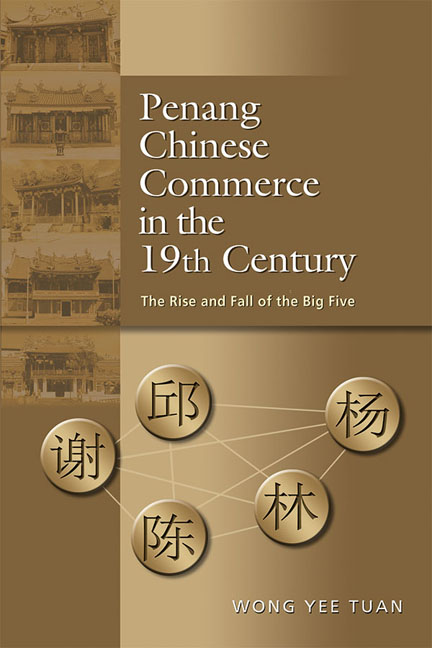Book contents
- Frontmatter
- Dedication
- Contents
- List of Tables, Diagrams and Maps
- Acknowledgements
- Glossary
- Abbreviations and Acronyms
- Notes on Spelling and Names
- Notes on Currencies
- Map
- 1 Introduction
- 2 Penang and the Big Five in Regional Context
- 3 Kith and Kin: The Big Five Familial Web
- 4 Opium Farm Rivalry
- 5 The Contest for ‘White Gold’
- 6 Western Mercantile Elite and Their Challenge to the Penang Chinese
- 7 New Regional Order and the Decline of the Big Five
- 8 Conclusion
- Appendices
- Bibliography
- Index
- About the Author
- Platesection
- Map
5 - The Contest for ‘White Gold’
Published online by Cambridge University Press: 19 May 2017
- Frontmatter
- Dedication
- Contents
- List of Tables, Diagrams and Maps
- Acknowledgements
- Glossary
- Abbreviations and Acronyms
- Notes on Spelling and Names
- Notes on Currencies
- Map
- 1 Introduction
- 2 Penang and the Big Five in Regional Context
- 3 Kith and Kin: The Big Five Familial Web
- 4 Opium Farm Rivalry
- 5 The Contest for ‘White Gold’
- 6 Western Mercantile Elite and Their Challenge to the Penang Chinese
- 7 New Regional Order and the Decline of the Big Five
- 8 Conclusion
- Appendices
- Bibliography
- Index
- About the Author
- Platesection
- Map
Summary
Tin had been mined and traded in Southeast Asia since at least the tenth century. Although the production and trade in the early period was limited in scale, tin was no doubt a valuable and popular commodity. The mountain ranges in peninsular Burma, Thailand and Malaya share the same geological structure of granite masses forming and contain rich tin reserves (Courtenay 1972, pp. 47–52; Ooi 1963, pp. 295–97). This tin belt, centred in Malaya and extending for hundred of miles northwards into southern Thailand and lower Burma, and southwards to the islands of Singkep, Bangka and Billiton, was the richest and most extensive in the world. It was not until the Industrial Revolution spurred the demand for tin and motivated Chinese merchants and miners, however, that this tin belt was turned into a production powerhouse. As mentioned in Chapter 2, the tin mining business in Phuket and Perak, the two richest tin producing states in the nineteenth century, was in the hands of the Big Five. But this does not mean that the Big Five faced no challenges. In fact, the competition for “White Gold” (tin) was no less than for “Black Gold” (opium). It is not surprising that the Ghee Hin was one of the most aggressive competitors, since tin mining was a very profitable enterprise and was also inextricably tied to the opium farming business. Besides Ghee Hin, the Singapore Hokkien mercantile elite also made attempts to break into the Big Five's tin mining domain in Larut of Perak. This chapter will examine the competition from the various sides and how the Big Five responded.
Larut and the Big Five's Tin Mining Interests
With the discovery of tin fields in late 1840s, Larut quickly became the magnet for coolies and capitalists from Penang. This phenomenon was due to the expansion of the U.K. tinplate industry which in turn led to an increasing demand for Straits tin. The Hakka from Zengcheng district of Guangdong province, who formed the majority of the members of the Hai San hui, were the first miners who went to Larut.
- Type
- Chapter
- Information
- Penang Chinese Commerce in the 19th CenturyThe Rise and Fall of the Big Five, pp. 86 - 101Publisher: ISEAS–Yusof Ishak InstitutePrint publication year: 2015

